Organizational Systems and Quality Leadership: RCA and FMEA Analysis
VerifiedAdded on 2023/04/21
|9
|2089
|226
Report
AI Summary
This report analyzes organizational systems and quality leadership within a healthcare context, focusing on Root Cause Analysis (RCA) and Failure Mode and Effects Analysis (FMEA). It begins by explaining the general purpose of RCA and outlines its six steps, using a case study involving a patient in an emergency department to illustrate causative and contributing factors. The report then details a process improvement plan based on Lewin's change management theory, including the 'Unfreeze, Change, and Refreeze' phases, and presents a Failure Mode and Effects Analysis (FMEA) implementation plan to assess and mitigate risks. It also discusses testing interventions, the role of professional nurses in demonstrating leadership through RCA and FMEA, and the importance of quality care and motivational programs for healthcare workers. The report concludes by emphasizing the systematic approach of RCA and FMEA in enhancing healthcare quality and patient safety, highlighting the role of leadership in promoting these improvements.

Running head: ORGANIZATIONAL SYSTEMS AND QUALITY LEADERSHIP
Organizational systems and quality leadership
Name of the Student
Name of the University
Author note
Organizational systems and quality leadership
Name of the Student
Name of the University
Author note
Paraphrase This Document
Need a fresh take? Get an instant paraphrase of this document with our AI Paraphraser
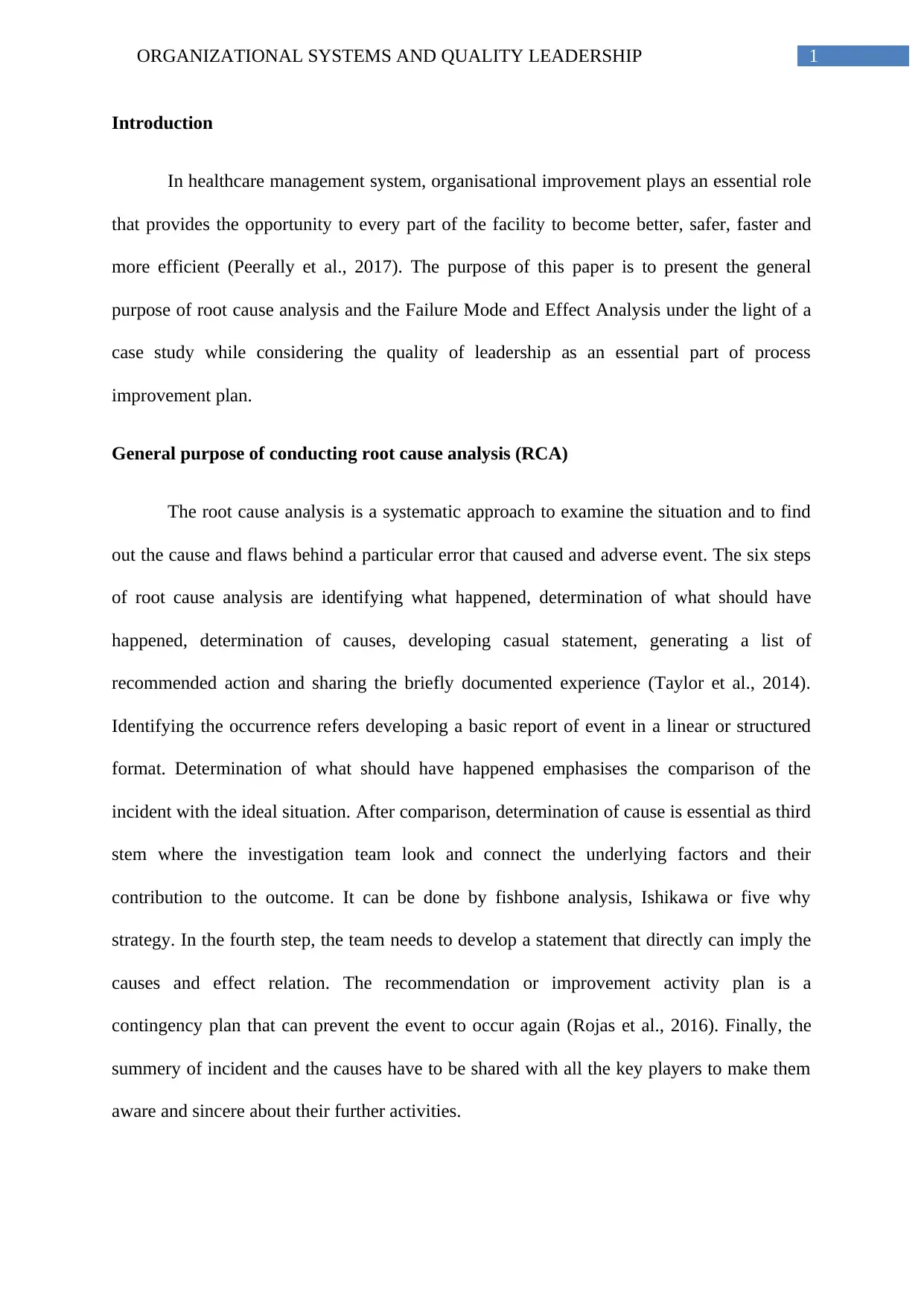
1ORGANIZATIONAL SYSTEMS AND QUALITY LEADERSHIP
Introduction
In healthcare management system, organisational improvement plays an essential role
that provides the opportunity to every part of the facility to become better, safer, faster and
more efficient (Peerally et al., 2017). The purpose of this paper is to present the general
purpose of root cause analysis and the Failure Mode and Effect Analysis under the light of a
case study while considering the quality of leadership as an essential part of process
improvement plan.
General purpose of conducting root cause analysis (RCA)
The root cause analysis is a systematic approach to examine the situation and to find
out the cause and flaws behind a particular error that caused and adverse event. The six steps
of root cause analysis are identifying what happened, determination of what should have
happened, determination of causes, developing casual statement, generating a list of
recommended action and sharing the briefly documented experience (Taylor et al., 2014).
Identifying the occurrence refers developing a basic report of event in a linear or structured
format. Determination of what should have happened emphasises the comparison of the
incident with the ideal situation. After comparison, determination of cause is essential as third
stem where the investigation team look and connect the underlying factors and their
contribution to the outcome. It can be done by fishbone analysis, Ishikawa or five why
strategy. In the fourth step, the team needs to develop a statement that directly can imply the
causes and effect relation. The recommendation or improvement activity plan is a
contingency plan that can prevent the event to occur again (Rojas et al., 2016). Finally, the
summery of incident and the causes have to be shared with all the key players to make them
aware and sincere about their further activities.
Introduction
In healthcare management system, organisational improvement plays an essential role
that provides the opportunity to every part of the facility to become better, safer, faster and
more efficient (Peerally et al., 2017). The purpose of this paper is to present the general
purpose of root cause analysis and the Failure Mode and Effect Analysis under the light of a
case study while considering the quality of leadership as an essential part of process
improvement plan.
General purpose of conducting root cause analysis (RCA)
The root cause analysis is a systematic approach to examine the situation and to find
out the cause and flaws behind a particular error that caused and adverse event. The six steps
of root cause analysis are identifying what happened, determination of what should have
happened, determination of causes, developing casual statement, generating a list of
recommended action and sharing the briefly documented experience (Taylor et al., 2014).
Identifying the occurrence refers developing a basic report of event in a linear or structured
format. Determination of what should have happened emphasises the comparison of the
incident with the ideal situation. After comparison, determination of cause is essential as third
stem where the investigation team look and connect the underlying factors and their
contribution to the outcome. It can be done by fishbone analysis, Ishikawa or five why
strategy. In the fourth step, the team needs to develop a statement that directly can imply the
causes and effect relation. The recommendation or improvement activity plan is a
contingency plan that can prevent the event to occur again (Rojas et al., 2016). Finally, the
summery of incident and the causes have to be shared with all the key players to make them
aware and sincere about their further activities.
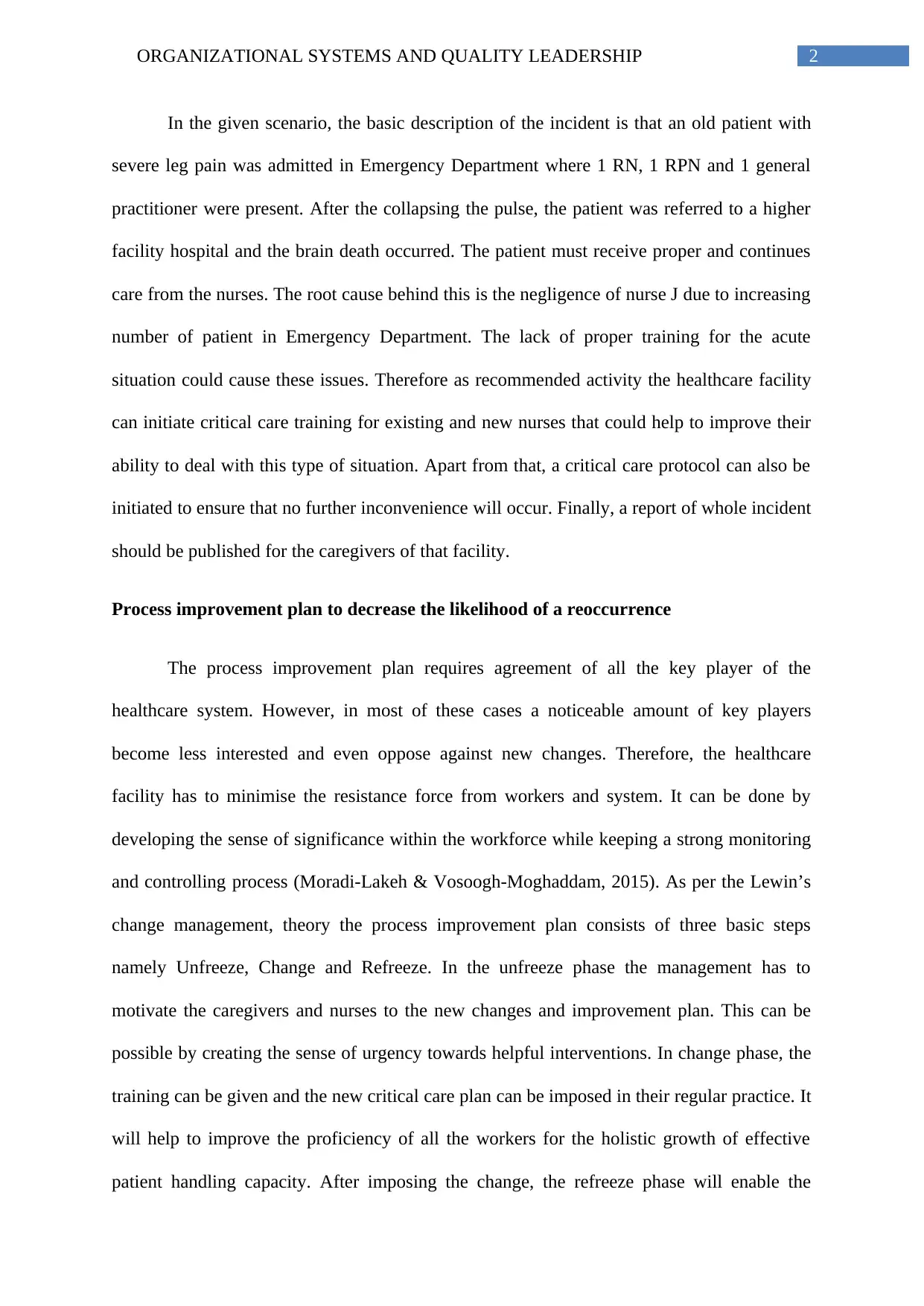
2ORGANIZATIONAL SYSTEMS AND QUALITY LEADERSHIP
In the given scenario, the basic description of the incident is that an old patient with
severe leg pain was admitted in Emergency Department where 1 RN, 1 RPN and 1 general
practitioner were present. After the collapsing the pulse, the patient was referred to a higher
facility hospital and the brain death occurred. The patient must receive proper and continues
care from the nurses. The root cause behind this is the negligence of nurse J due to increasing
number of patient in Emergency Department. The lack of proper training for the acute
situation could cause these issues. Therefore as recommended activity the healthcare facility
can initiate critical care training for existing and new nurses that could help to improve their
ability to deal with this type of situation. Apart from that, a critical care protocol can also be
initiated to ensure that no further inconvenience will occur. Finally, a report of whole incident
should be published for the caregivers of that facility.
Process improvement plan to decrease the likelihood of a reoccurrence
The process improvement plan requires agreement of all the key player of the
healthcare system. However, in most of these cases a noticeable amount of key players
become less interested and even oppose against new changes. Therefore, the healthcare
facility has to minimise the resistance force from workers and system. It can be done by
developing the sense of significance within the workforce while keeping a strong monitoring
and controlling process (Moradi-Lakeh & Vosoogh-Moghaddam, 2015). As per the Lewin’s
change management, theory the process improvement plan consists of three basic steps
namely Unfreeze, Change and Refreeze. In the unfreeze phase the management has to
motivate the caregivers and nurses to the new changes and improvement plan. This can be
possible by creating the sense of urgency towards helpful interventions. In change phase, the
training can be given and the new critical care plan can be imposed in their regular practice. It
will help to improve the proficiency of all the workers for the holistic growth of effective
patient handling capacity. After imposing the change, the refreeze phase will enable the
In the given scenario, the basic description of the incident is that an old patient with
severe leg pain was admitted in Emergency Department where 1 RN, 1 RPN and 1 general
practitioner were present. After the collapsing the pulse, the patient was referred to a higher
facility hospital and the brain death occurred. The patient must receive proper and continues
care from the nurses. The root cause behind this is the negligence of nurse J due to increasing
number of patient in Emergency Department. The lack of proper training for the acute
situation could cause these issues. Therefore as recommended activity the healthcare facility
can initiate critical care training for existing and new nurses that could help to improve their
ability to deal with this type of situation. Apart from that, a critical care protocol can also be
initiated to ensure that no further inconvenience will occur. Finally, a report of whole incident
should be published for the caregivers of that facility.
Process improvement plan to decrease the likelihood of a reoccurrence
The process improvement plan requires agreement of all the key player of the
healthcare system. However, in most of these cases a noticeable amount of key players
become less interested and even oppose against new changes. Therefore, the healthcare
facility has to minimise the resistance force from workers and system. It can be done by
developing the sense of significance within the workforce while keeping a strong monitoring
and controlling process (Moradi-Lakeh & Vosoogh-Moghaddam, 2015). As per the Lewin’s
change management, theory the process improvement plan consists of three basic steps
namely Unfreeze, Change and Refreeze. In the unfreeze phase the management has to
motivate the caregivers and nurses to the new changes and improvement plan. This can be
possible by creating the sense of urgency towards helpful interventions. In change phase, the
training can be given and the new critical care plan can be imposed in their regular practice. It
will help to improve the proficiency of all the workers for the holistic growth of effective
patient handling capacity. After imposing the change, the refreeze phase will enable the
⊘ This is a preview!⊘
Do you want full access?
Subscribe today to unlock all pages.

Trusted by 1+ million students worldwide
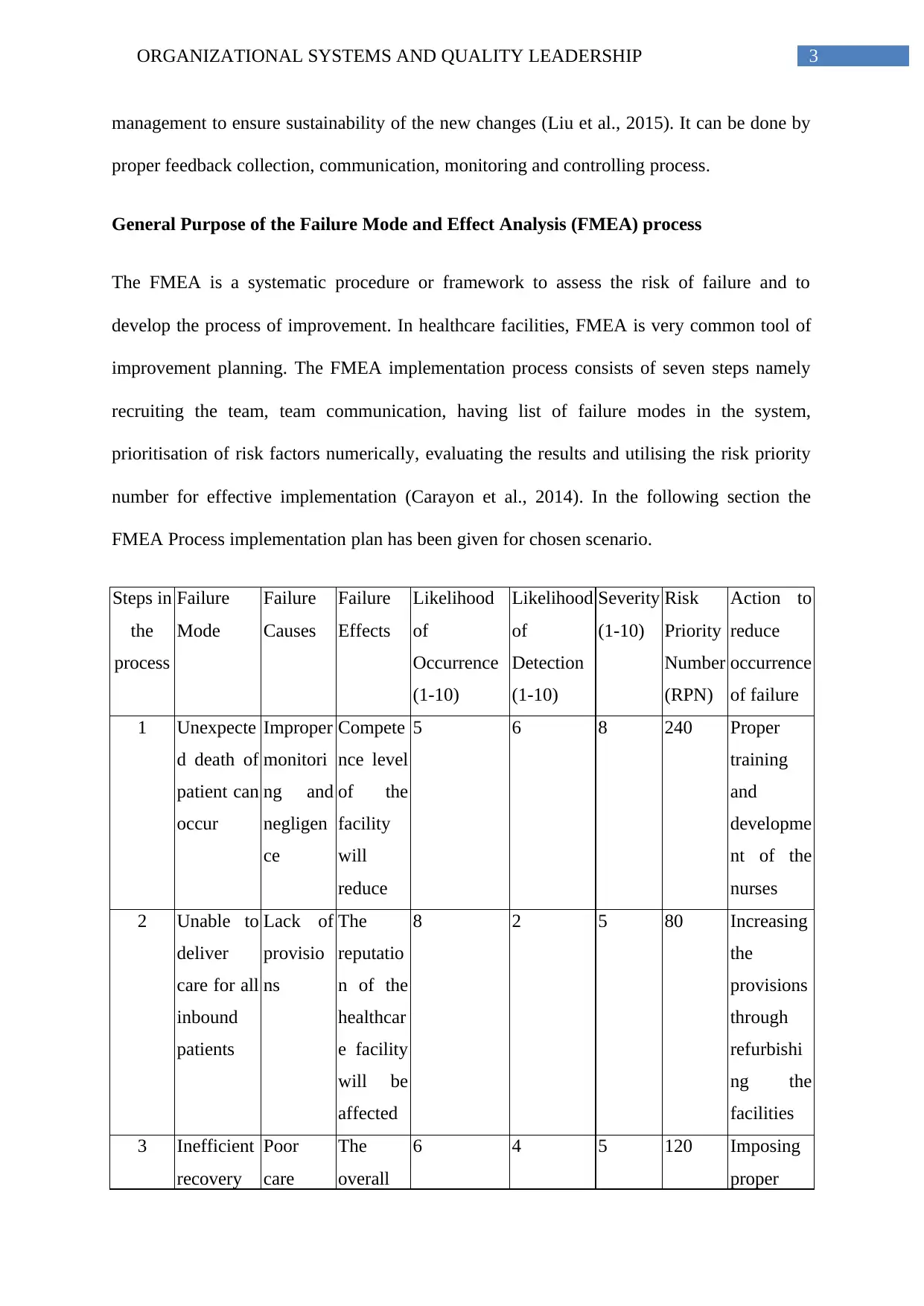
3ORGANIZATIONAL SYSTEMS AND QUALITY LEADERSHIP
management to ensure sustainability of the new changes (Liu et al., 2015). It can be done by
proper feedback collection, communication, monitoring and controlling process.
General Purpose of the Failure Mode and Effect Analysis (FMEA) process
The FMEA is a systematic procedure or framework to assess the risk of failure and to
develop the process of improvement. In healthcare facilities, FMEA is very common tool of
improvement planning. The FMEA implementation process consists of seven steps namely
recruiting the team, team communication, having list of failure modes in the system,
prioritisation of risk factors numerically, evaluating the results and utilising the risk priority
number for effective implementation (Carayon et al., 2014). In the following section the
FMEA Process implementation plan has been given for chosen scenario.
Steps in
the
process
Failure
Mode
Failure
Causes
Failure
Effects
Likelihood
of
Occurrence
(1-10)
Likelihood
of
Detection
(1-10)
Severity
(1-10)
Risk
Priority
Number
(RPN)
Action to
reduce
occurrence
of failure
1 Unexpecte
d death of
patient can
occur
Improper
monitori
ng and
negligen
ce
Compete
nce level
of the
facility
will
reduce
5 6 8 240 Proper
training
and
developme
nt of the
nurses
2 Unable to
deliver
care for all
inbound
patients
Lack of
provisio
ns
The
reputatio
n of the
healthcar
e facility
will be
affected
8 2 5 80 Increasing
the
provisions
through
refurbishi
ng the
facilities
3 Inefficient
recovery
Poor
care
The
overall
6 4 5 120 Imposing
proper
management to ensure sustainability of the new changes (Liu et al., 2015). It can be done by
proper feedback collection, communication, monitoring and controlling process.
General Purpose of the Failure Mode and Effect Analysis (FMEA) process
The FMEA is a systematic procedure or framework to assess the risk of failure and to
develop the process of improvement. In healthcare facilities, FMEA is very common tool of
improvement planning. The FMEA implementation process consists of seven steps namely
recruiting the team, team communication, having list of failure modes in the system,
prioritisation of risk factors numerically, evaluating the results and utilising the risk priority
number for effective implementation (Carayon et al., 2014). In the following section the
FMEA Process implementation plan has been given for chosen scenario.
Steps in
the
process
Failure
Mode
Failure
Causes
Failure
Effects
Likelihood
of
Occurrence
(1-10)
Likelihood
of
Detection
(1-10)
Severity
(1-10)
Risk
Priority
Number
(RPN)
Action to
reduce
occurrence
of failure
1 Unexpecte
d death of
patient can
occur
Improper
monitori
ng and
negligen
ce
Compete
nce level
of the
facility
will
reduce
5 6 8 240 Proper
training
and
developme
nt of the
nurses
2 Unable to
deliver
care for all
inbound
patients
Lack of
provisio
ns
The
reputatio
n of the
healthcar
e facility
will be
affected
8 2 5 80 Increasing
the
provisions
through
refurbishi
ng the
facilities
3 Inefficient
recovery
Poor
care
The
overall
6 4 5 120 Imposing
proper
Paraphrase This Document
Need a fresh take? Get an instant paraphrase of this document with our AI Paraphraser
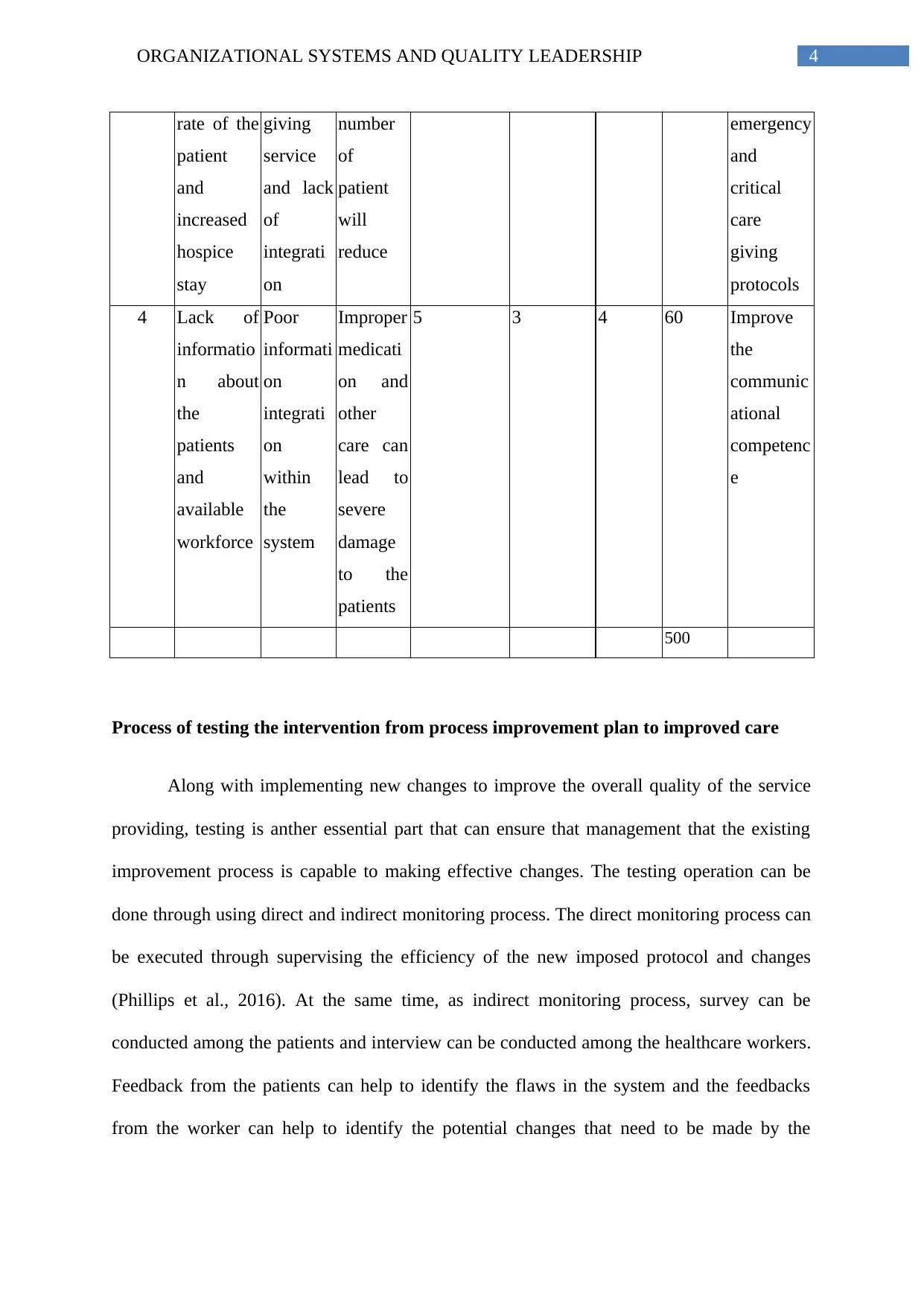
4ORGANIZATIONAL SYSTEMS AND QUALITY LEADERSHIP
rate of the
patient
and
increased
hospice
stay
giving
service
and lack
of
integrati
on
number
of
patient
will
reduce
emergency
and
critical
care
giving
protocols
4 Lack of
informatio
n about
the
patients
and
available
workforce
Poor
informati
on
integrati
on
within
the
system
Improper
medicati
on and
other
care can
lead to
severe
damage
to the
patients
5 3 4 60 Improve
the
communic
ational
competenc
e
500
Process of testing the intervention from process improvement plan to improved care
Along with implementing new changes to improve the overall quality of the service
providing, testing is anther essential part that can ensure that management that the existing
improvement process is capable to making effective changes. The testing operation can be
done through using direct and indirect monitoring process. The direct monitoring process can
be executed through supervising the efficiency of the new imposed protocol and changes
(Phillips et al., 2016). At the same time, as indirect monitoring process, survey can be
conducted among the patients and interview can be conducted among the healthcare workers.
Feedback from the patients can help to identify the flaws in the system and the feedbacks
from the worker can help to identify the potential changes that need to be made by the
rate of the
patient
and
increased
hospice
stay
giving
service
and lack
of
integrati
on
number
of
patient
will
reduce
emergency
and
critical
care
giving
protocols
4 Lack of
informatio
n about
the
patients
and
available
workforce
Poor
informati
on
integrati
on
within
the
system
Improper
medicati
on and
other
care can
lead to
severe
damage
to the
patients
5 3 4 60 Improve
the
communic
ational
competenc
e
500
Process of testing the intervention from process improvement plan to improved care
Along with implementing new changes to improve the overall quality of the service
providing, testing is anther essential part that can ensure that management that the existing
improvement process is capable to making effective changes. The testing operation can be
done through using direct and indirect monitoring process. The direct monitoring process can
be executed through supervising the efficiency of the new imposed protocol and changes
(Phillips et al., 2016). At the same time, as indirect monitoring process, survey can be
conducted among the patients and interview can be conducted among the healthcare workers.
Feedback from the patients can help to identify the flaws in the system and the feedbacks
from the worker can help to identify the potential changes that need to be made by the
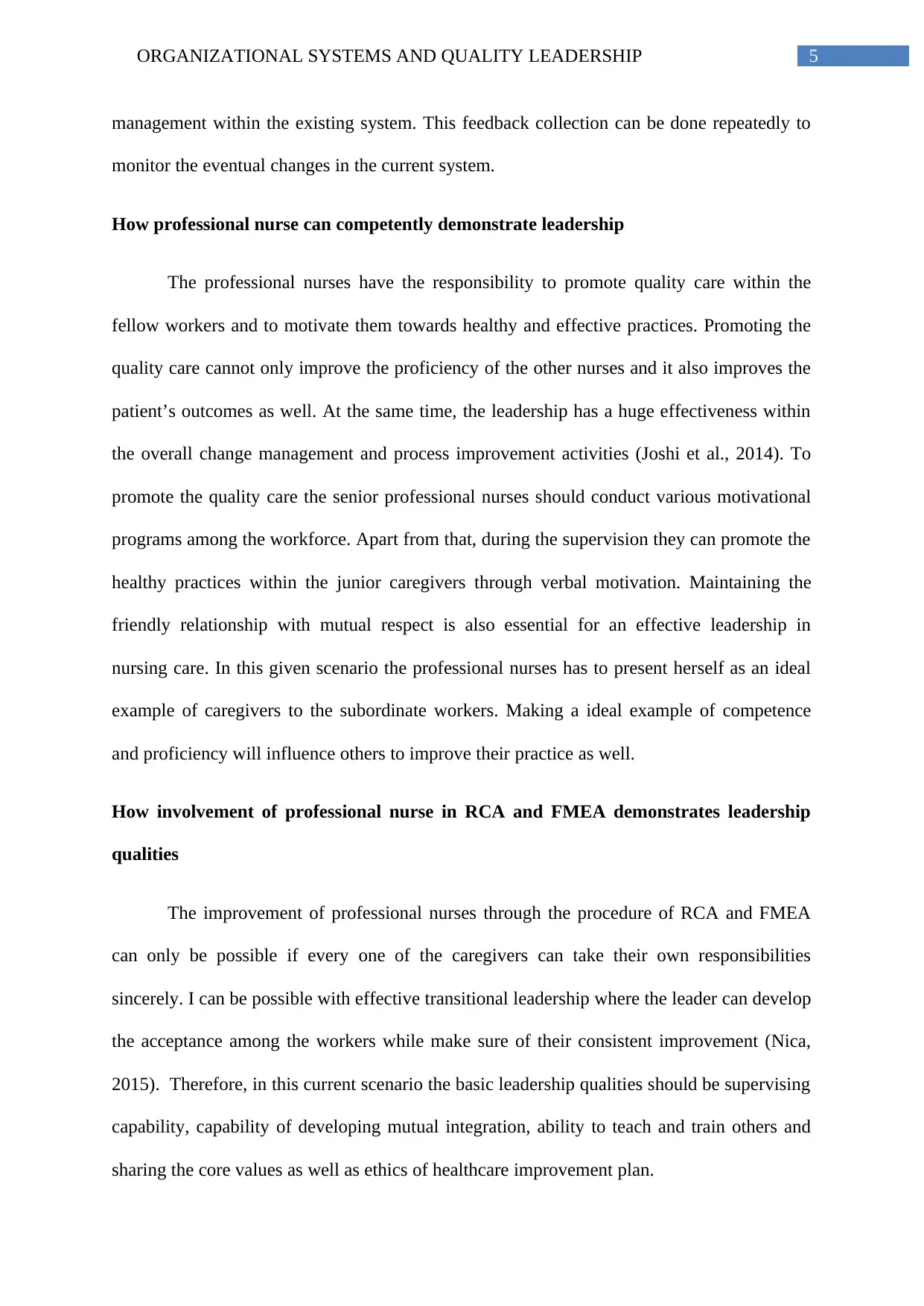
5ORGANIZATIONAL SYSTEMS AND QUALITY LEADERSHIP
management within the existing system. This feedback collection can be done repeatedly to
monitor the eventual changes in the current system.
How professional nurse can competently demonstrate leadership
The professional nurses have the responsibility to promote quality care within the
fellow workers and to motivate them towards healthy and effective practices. Promoting the
quality care cannot only improve the proficiency of the other nurses and it also improves the
patient’s outcomes as well. At the same time, the leadership has a huge effectiveness within
the overall change management and process improvement activities (Joshi et al., 2014). To
promote the quality care the senior professional nurses should conduct various motivational
programs among the workforce. Apart from that, during the supervision they can promote the
healthy practices within the junior caregivers through verbal motivation. Maintaining the
friendly relationship with mutual respect is also essential for an effective leadership in
nursing care. In this given scenario the professional nurses has to present herself as an ideal
example of caregivers to the subordinate workers. Making a ideal example of competence
and proficiency will influence others to improve their practice as well.
How involvement of professional nurse in RCA and FMEA demonstrates leadership
qualities
The improvement of professional nurses through the procedure of RCA and FMEA
can only be possible if every one of the caregivers can take their own responsibilities
sincerely. I can be possible with effective transitional leadership where the leader can develop
the acceptance among the workers while make sure of their consistent improvement (Nica,
2015). Therefore, in this current scenario the basic leadership qualities should be supervising
capability, capability of developing mutual integration, ability to teach and train others and
sharing the core values as well as ethics of healthcare improvement plan.
management within the existing system. This feedback collection can be done repeatedly to
monitor the eventual changes in the current system.
How professional nurse can competently demonstrate leadership
The professional nurses have the responsibility to promote quality care within the
fellow workers and to motivate them towards healthy and effective practices. Promoting the
quality care cannot only improve the proficiency of the other nurses and it also improves the
patient’s outcomes as well. At the same time, the leadership has a huge effectiveness within
the overall change management and process improvement activities (Joshi et al., 2014). To
promote the quality care the senior professional nurses should conduct various motivational
programs among the workforce. Apart from that, during the supervision they can promote the
healthy practices within the junior caregivers through verbal motivation. Maintaining the
friendly relationship with mutual respect is also essential for an effective leadership in
nursing care. In this given scenario the professional nurses has to present herself as an ideal
example of caregivers to the subordinate workers. Making a ideal example of competence
and proficiency will influence others to improve their practice as well.
How involvement of professional nurse in RCA and FMEA demonstrates leadership
qualities
The improvement of professional nurses through the procedure of RCA and FMEA
can only be possible if every one of the caregivers can take their own responsibilities
sincerely. I can be possible with effective transitional leadership where the leader can develop
the acceptance among the workers while make sure of their consistent improvement (Nica,
2015). Therefore, in this current scenario the basic leadership qualities should be supervising
capability, capability of developing mutual integration, ability to teach and train others and
sharing the core values as well as ethics of healthcare improvement plan.
⊘ This is a preview!⊘
Do you want full access?
Subscribe today to unlock all pages.

Trusted by 1+ million students worldwide
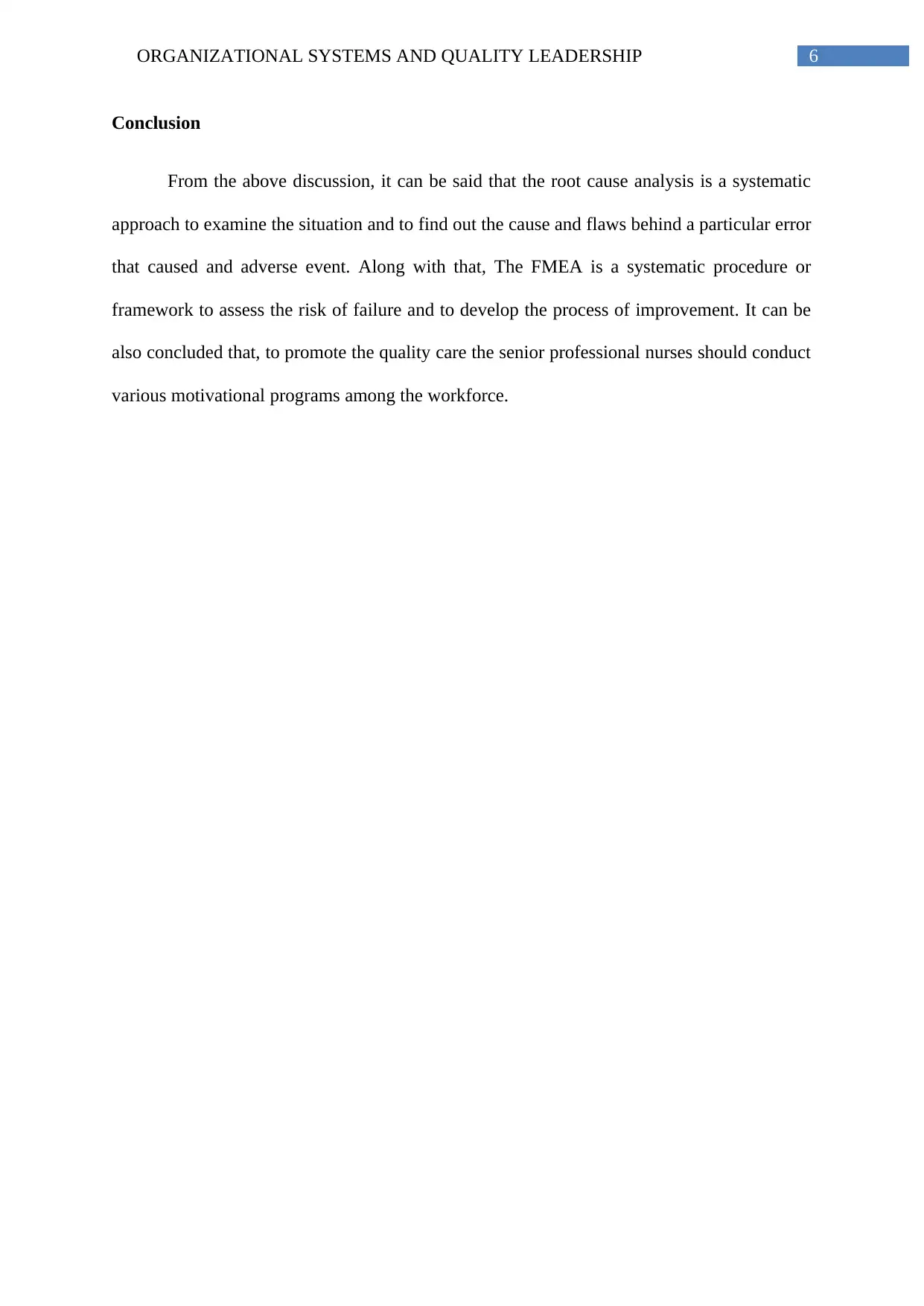
6ORGANIZATIONAL SYSTEMS AND QUALITY LEADERSHIP
Conclusion
From the above discussion, it can be said that the root cause analysis is a systematic
approach to examine the situation and to find out the cause and flaws behind a particular error
that caused and adverse event. Along with that, The FMEA is a systematic procedure or
framework to assess the risk of failure and to develop the process of improvement. It can be
also concluded that, to promote the quality care the senior professional nurses should conduct
various motivational programs among the workforce.
Conclusion
From the above discussion, it can be said that the root cause analysis is a systematic
approach to examine the situation and to find out the cause and flaws behind a particular error
that caused and adverse event. Along with that, The FMEA is a systematic procedure or
framework to assess the risk of failure and to develop the process of improvement. It can be
also concluded that, to promote the quality care the senior professional nurses should conduct
various motivational programs among the workforce.
Paraphrase This Document
Need a fresh take? Get an instant paraphrase of this document with our AI Paraphraser
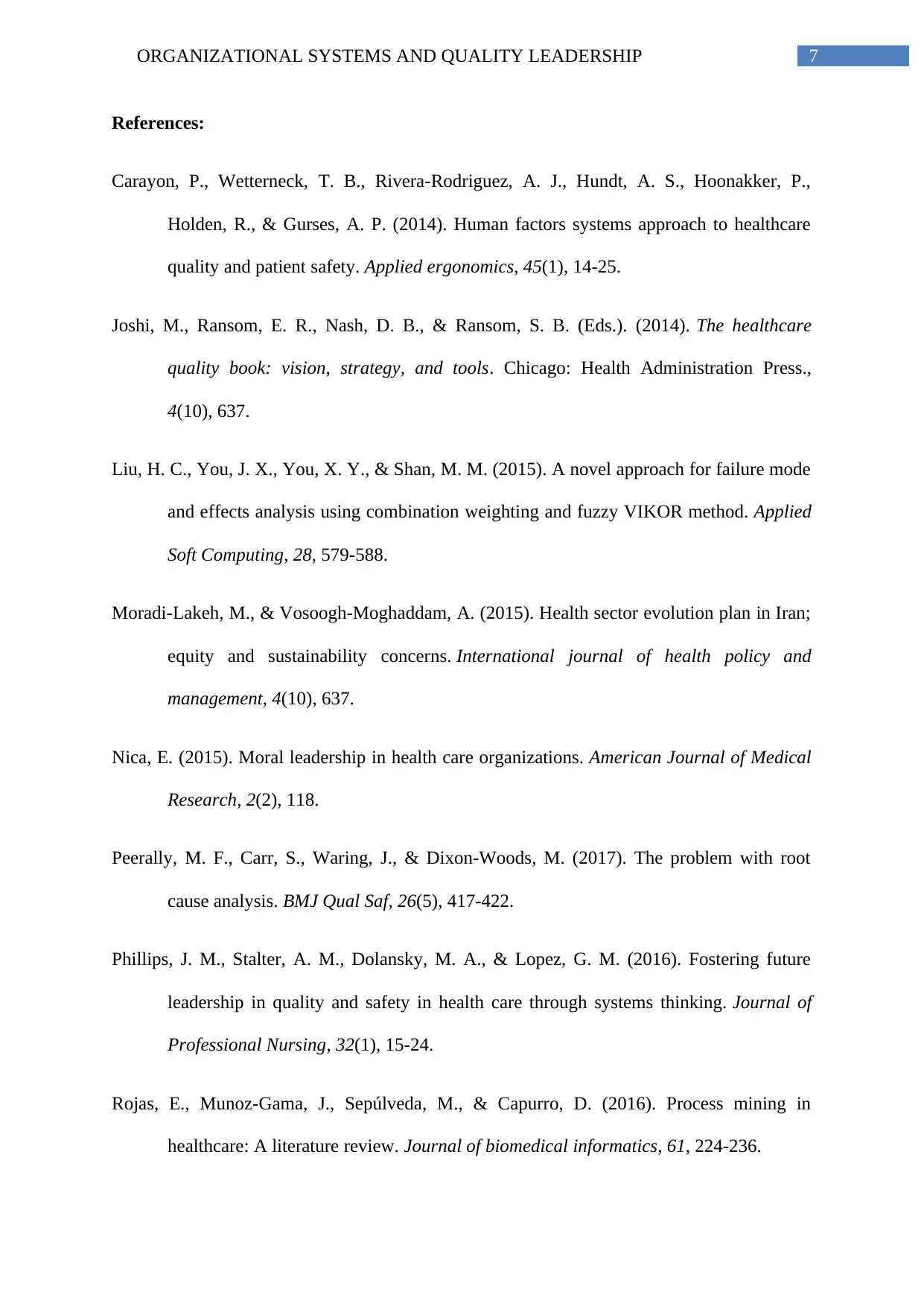
7ORGANIZATIONAL SYSTEMS AND QUALITY LEADERSHIP
References:
Carayon, P., Wetterneck, T. B., Rivera-Rodriguez, A. J., Hundt, A. S., Hoonakker, P.,
Holden, R., & Gurses, A. P. (2014). Human factors systems approach to healthcare
quality and patient safety. Applied ergonomics, 45(1), 14-25.
Joshi, M., Ransom, E. R., Nash, D. B., & Ransom, S. B. (Eds.). (2014). The healthcare
quality book: vision, strategy, and tools. Chicago: Health Administration Press.,
4(10), 637.
Liu, H. C., You, J. X., You, X. Y., & Shan, M. M. (2015). A novel approach for failure mode
and effects analysis using combination weighting and fuzzy VIKOR method. Applied
Soft Computing, 28, 579-588.
Moradi-Lakeh, M., & Vosoogh-Moghaddam, A. (2015). Health sector evolution plan in Iran;
equity and sustainability concerns. International journal of health policy and
management, 4(10), 637.
Nica, E. (2015). Moral leadership in health care organizations. American Journal of Medical
Research, 2(2), 118.
Peerally, M. F., Carr, S., Waring, J., & Dixon-Woods, M. (2017). The problem with root
cause analysis. BMJ Qual Saf, 26(5), 417-422.
Phillips, J. M., Stalter, A. M., Dolansky, M. A., & Lopez, G. M. (2016). Fostering future
leadership in quality and safety in health care through systems thinking. Journal of
Professional Nursing, 32(1), 15-24.
Rojas, E., Munoz-Gama, J., Sepúlveda, M., & Capurro, D. (2016). Process mining in
healthcare: A literature review. Journal of biomedical informatics, 61, 224-236.
References:
Carayon, P., Wetterneck, T. B., Rivera-Rodriguez, A. J., Hundt, A. S., Hoonakker, P.,
Holden, R., & Gurses, A. P. (2014). Human factors systems approach to healthcare
quality and patient safety. Applied ergonomics, 45(1), 14-25.
Joshi, M., Ransom, E. R., Nash, D. B., & Ransom, S. B. (Eds.). (2014). The healthcare
quality book: vision, strategy, and tools. Chicago: Health Administration Press.,
4(10), 637.
Liu, H. C., You, J. X., You, X. Y., & Shan, M. M. (2015). A novel approach for failure mode
and effects analysis using combination weighting and fuzzy VIKOR method. Applied
Soft Computing, 28, 579-588.
Moradi-Lakeh, M., & Vosoogh-Moghaddam, A. (2015). Health sector evolution plan in Iran;
equity and sustainability concerns. International journal of health policy and
management, 4(10), 637.
Nica, E. (2015). Moral leadership in health care organizations. American Journal of Medical
Research, 2(2), 118.
Peerally, M. F., Carr, S., Waring, J., & Dixon-Woods, M. (2017). The problem with root
cause analysis. BMJ Qual Saf, 26(5), 417-422.
Phillips, J. M., Stalter, A. M., Dolansky, M. A., & Lopez, G. M. (2016). Fostering future
leadership in quality and safety in health care through systems thinking. Journal of
Professional Nursing, 32(1), 15-24.
Rojas, E., Munoz-Gama, J., Sepúlveda, M., & Capurro, D. (2016). Process mining in
healthcare: A literature review. Journal of biomedical informatics, 61, 224-236.
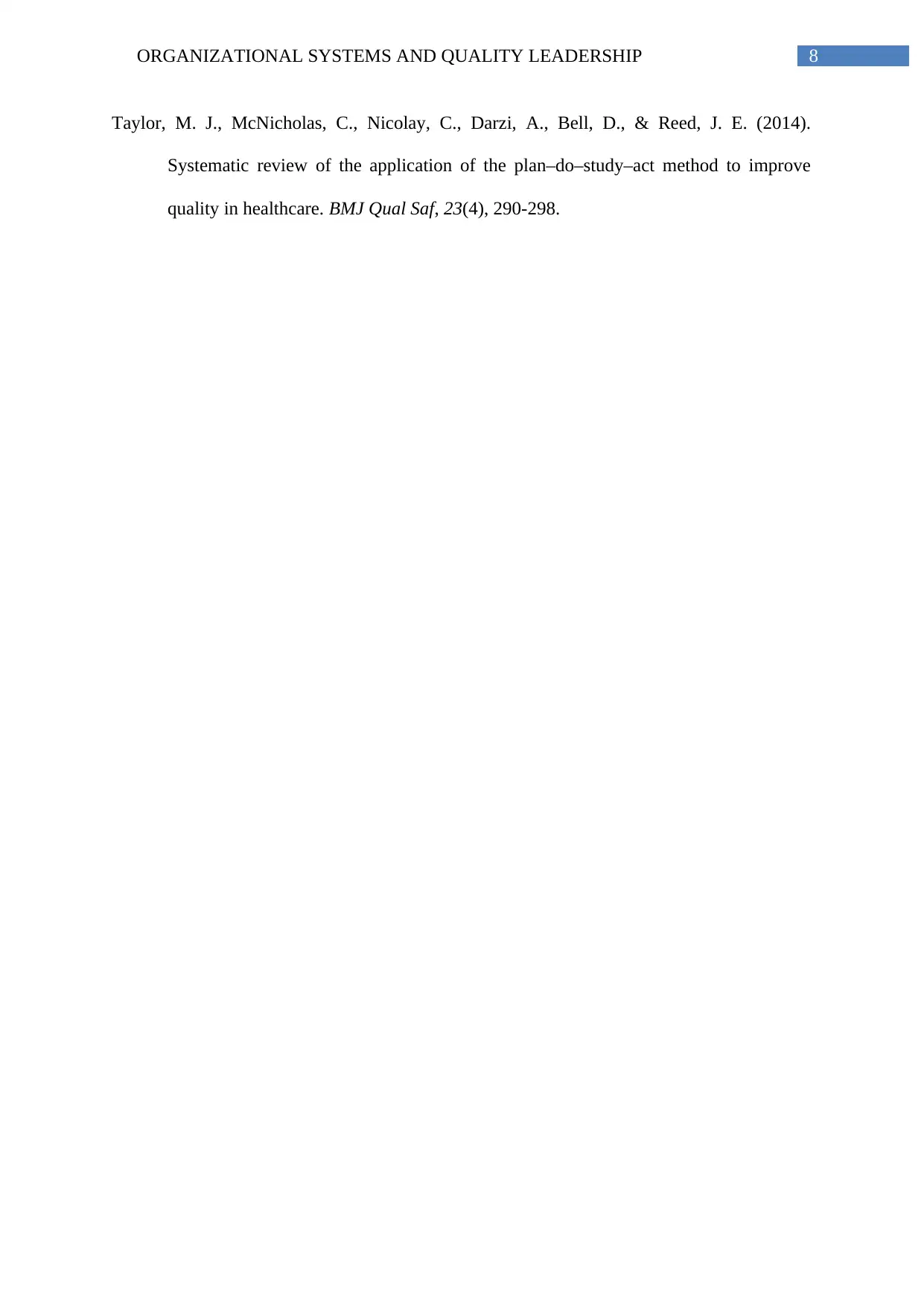
8ORGANIZATIONAL SYSTEMS AND QUALITY LEADERSHIP
Taylor, M. J., McNicholas, C., Nicolay, C., Darzi, A., Bell, D., & Reed, J. E. (2014).
Systematic review of the application of the plan–do–study–act method to improve
quality in healthcare. BMJ Qual Saf, 23(4), 290-298.
Taylor, M. J., McNicholas, C., Nicolay, C., Darzi, A., Bell, D., & Reed, J. E. (2014).
Systematic review of the application of the plan–do–study–act method to improve
quality in healthcare. BMJ Qual Saf, 23(4), 290-298.
⊘ This is a preview!⊘
Do you want full access?
Subscribe today to unlock all pages.

Trusted by 1+ million students worldwide
1 out of 9
Related Documents
Your All-in-One AI-Powered Toolkit for Academic Success.
+13062052269
info@desklib.com
Available 24*7 on WhatsApp / Email
![[object Object]](/_next/static/media/star-bottom.7253800d.svg)
Unlock your academic potential
Copyright © 2020–2025 A2Z Services. All Rights Reserved. Developed and managed by ZUCOL.





